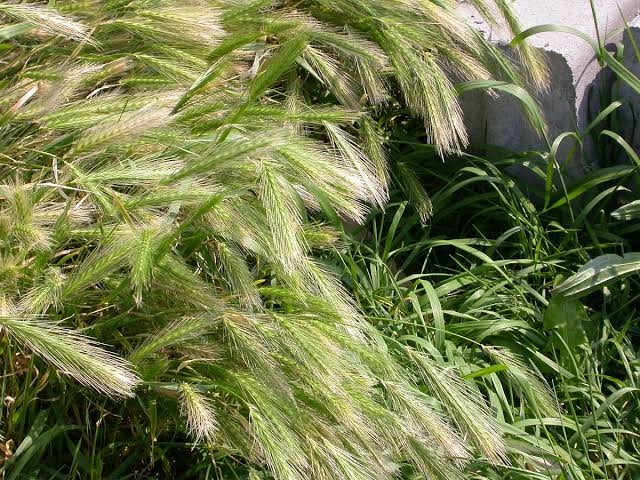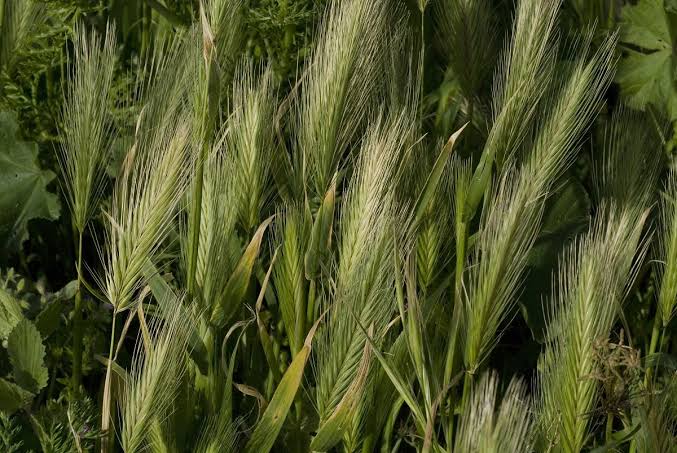Wall barley (Hordeum murinum ssp. Murinum) is a type of grass that you can find in many places. It’s a common plant that grows in fields, gardens, and along roadsides. This grass is part of the Hordeum murinum species, specifically the ssp. Murinum subspecies.
The appearance of Wall barley is quite distinct. It has long, slender stems that can grow to different heights. The leaves are green and narrow, giving the plant a simple and elegant look. You might notice tiny flowers on Wall barley during certain times of the year. These flowers can add a touch of delicacy to the grass.
One interesting thing about Wall barley is its adaptability. This grass can grow in various conditions, from sunny fields to shaded areas near walls, which is how it got its name. It’s not picky about soil types and can thrive in different environments. This adaptability makes Wall barley a resilient and widespread plant.
Gardeners sometimes encounter Wall barley as a weed, but it has its own charm. Some people appreciate the natural beauty it brings to outdoor spaces. Additionally, Wall barley plays a role in supporting biodiversity by providing habitat and food for insects and small animals.
Understanding the life cycle of Wall barley can be fascinating. Like many grasses, it goes through stages of germination, growth, flowering, and seed production. Observing these stages can give you insights into the plant’s biology and how it interacts with its surroundings.
In addition, Wall barley is a common grass with a distinctive appearance that you can find in various places. Its adaptability, simple beauty, and role in supporting biodiversity make it an interesting element of the natural world. Whether you encounter it in a field, garden, or by a wall, take a moment to appreciate the subtle elegance of Wall barley.
Read Also: Planting, Growing and Harvesting Grapes
How To Grow Wall Barley (Hordeum murinum ssp. Murinum)

Growing Wall barley (Hordeum murinum ssp. Murinum) can be a straightforward and rewarding process. Here’s a simple guide to help you cultivate this grass:
1. Selection of Location: Choose a sunny or partially shaded location for planting Wall barley. It is known for its adaptability, so it can grow in various soil types.
2. Soil Preparation: Prepare the soil by loosening it with a garden fork or tiller. Wall barley doesn’t require highly fertile soil, but well-draining soil is essential.
3. Planting Seeds: Scatter Wall barley seeds evenly over the prepared soil. Gently press the seeds into the soil, but avoid burying them too deep. Water the area lightly after planting.
4. Watering: Keep the soil consistently moist until the Wall barley seeds germinate and the seedlings establish. Once established, Wall barley is relatively drought-tolerant.
5. Maintenance: Wall barley doesn’t demand much attention. Remove any competing weeds to give it space to grow. Regular watering can help in the initial stages of growth.
6. Growth and Development: Observe the stages of growth, from the emergence of young shoots to the development of flowering spikes. Wall barley can reach varying heights, and its slender stems add a graceful touch to the landscape.
7. Harvesting: Wall barley is not typically grown for harvest, but you can enjoy its natural beauty in your garden. If you prefer a neater appearance, trim the tops when the plant starts to produce seeds.
8. Controlling Spread: Be mindful that Wall barley can spread easily. If you want to control its growth, consider planting it in contained areas or regularly trimming back any unwanted growth.
9. Enjoying Biodiversity: Allow Wall barley to coexist with other plants in your garden, as it can attract insects and contribute to the overall biodiversity of your outdoor space.
10. Observation: Take the time to observe the life cycle of Wall barley. Notice how it adapts to different conditions and appreciate its natural charm.
Growing Wall barley is a simple and enjoyable experience that can add a touch of nature to your garden or outdoor space. Whether you appreciate it for its resilience, beauty, or contribution to biodiversity, cultivating Wall barley can be a rewarding endeavor.
How To Care For Wall Barley (Hordeum murinum ssp. Murinum)
Caring for Wall barley (Hordeum murinum ssp. Murinum) is relatively easy, as it is a hardy and adaptable grass. Here are some simple care tips to ensure the well-being of your Wall barley:
1. Watering: Wall barley is drought-tolerant once established, but regular watering during dry spells can promote healthy growth. Water the plant deeply, allowing the soil to dry between watering sessions.
2. Soil Conditions: While Wall barley is adaptable to various soil types, it prefers well-draining soil. Ensure good drainage to prevent waterlogging, especially in clayey soils.
3. Sunlight: Wall barley thrives in full sun to partial shade. Plant it in a location where it receives adequate sunlight for a significant part of the day.
4. Pruning: Wall barley is a low-maintenance grass, but if you want to control its size or prevent it from spreading too much, trim it back periodically. This can also help maintain a neat appearance.
5. Weed Control: Keep the area around Wall barley free from competing weeds. Weeds can hinder its growth and may compete for nutrients.
6. Fertilization: Wall barley generally doesn’t require heavy fertilization. If your soil lacks nutrients, you can apply a balanced fertilizer in the spring to support healthy growth.
7. Pest Management: Wall barley is not highly susceptible to pests, but occasional inspection for any signs of pest damage is advisable. Treat any issues promptly to prevent widespread damage.
8. Biodiversity Support: Embrace Wall barley as part of your garden’s ecosystem. It can attract beneficial insects and contribute to biodiversity. Avoid using excessive pesticides that may harm these helpful creatures.
9. Observing Growth: Take time to observe the different stages of Wall barley’s growth. From the emergence of shoots to the development of seeds, appreciating the natural life cycle adds to the enjoyment of caring for this grass.
10. Containment: If you want to control the spread of Wall barley, consider planting it in contained areas or using barriers to limit its growth.
Caring for Wall barley involves providing it with basic necessities such as water, sunlight, and occasional maintenance. Its adaptability makes it a resilient and easy-to-manage addition to gardens and landscapes. By following these care tips, you can ensure that your Wall barley remains a healthy and attractive part of your outdoor space.
Read Also: How to Grow Paw-Paw (papayas): Beginners Business Guide
The Uses of Wall Barley (Hordeum murinum ssp. Murinum)

Wall barley (Hordeum murinum ssp. Murinum) may be considered a weed by some, but it does have several uses and benefits:
1. Erosion Control: Wall barley can be useful in preventing soil erosion. Its extensive root system helps bind the soil together, reducing the risk of erosion in areas prone to soil movement.
2. Wildlife Habitat: The grass provides habitat and food for various insects and small animals. Allowing Wall barley to grow in certain areas can contribute to local biodiversity by supporting a diverse range of wildlife.
3. Decorative Landscaping: Some people appreciate the simple beauty of Wall barley and intentionally incorporate it into their landscaping for a natural and rustic look. Its slender stems and delicate appearance can add an aesthetic touch to outdoor spaces.
4. Green Manure: When Wall barley is incorporated back into the soil, it can act as green manure. This means it adds organic matter to the soil as it decomposes, enhancing soil fertility.
5. Educational Purposes: Wall barley can serve educational purposes, especially in botanical studies. Observing its life cycle and growth patterns can provide valuable insights into the ecology of grass species.
6. Livestock Forage: While Wall barley is not a primary forage crop, some livestock may graze on it. However, it’s essential to monitor and control grazing to avoid overconsumption, as excessive intake can lead to potential health issues in animals.
7. Medicinal Uses: Traditionally, some cultures have explored medicinal uses for barley, including Wall barley. While not as commonly utilized for medicinal purposes as cultivated barley, some people believe it may have health benefits.
8. Culinary Exploration: While not a widespread practice, some foragers experiment with using Wall barley in culinary creations. It’s essential to exercise caution and ensure that the specific variety is safe for consumption.
9. Soil Stabilization: The robust root system of Wall barley helps stabilize soil, making it a useful plant in areas where soil movement is a concern. This can be particularly beneficial in preventing landslides or maintaining the integrity of slopes.
Understanding and appreciating the potential uses of Wall barley can lead to a more nuanced perspective on this seemingly ubiquitous grass. Whether for its ecological contributions, landscaping appeal, or specific applications, Wall barley demonstrates its versatility in various contexts.
Frequently Asked Questions (FAQs)
Q: Is Wall barley a weed, and should I remove it from my garden?
A: Wall barley is often considered a weed, but some gardeners appreciate its natural beauty. If it interferes with your plants, you may choose to control its growth, but others intentionally incorporate it into their landscaping.
Q: Can Wall barley be harmful to other plants in my garden?
A: While Wall barley itself is not typically harmful to other plants, it can compete for resources. Regular maintenance, such as pruning and weeding, can help manage its growth and prevent interference.
Q: Is Wall barley safe for my pets to be around?
A: Wall barley is generally safe for pets, but it’s advisable to monitor their behavior. Some animals may graze on it, but excessive consumption should be avoided. If you have concerns, consult with a veterinarian.
Q: Can I use Wall barley for mulching or as a ground cover?
A: Wall barley can be used as a natural ground cover, especially in areas where you want to prevent soil erosion. As it decomposes, it adds organic matter to the soil, acting as a form of green manure.
Q: Does Wall barley require a lot of water?
A: Wall barley is relatively drought-tolerant once established. While it benefits from regular watering, it does not demand excessive moisture. Allow the soil to dry between watering sessions.
Q: Can Wall barley be grown in containers?
A: While Wall barley is adaptable, it may not be the best choice for container gardening. Its natural growth habit and extensive root system are better suited for open garden spaces.
Q: How do I prevent Wall barley from spreading too much?
A: To control the spread of Wall barley, consider planting it in contained areas or using barriers to limit its growth. Regular pruning can also help maintain a more compact appearance.
Q: Is Wall barley the same as cultivated barley used for food and brewing?
A: No, Wall barley (Hordeum murinum ssp. Murinum) is a wild grass and is not the same as cultivated barley used for food and brewing. The cultivated barley has been selectively bred for specific traits.
Q: Can I harvest Wall barley for any practical uses?
A: While Wall barley is not typically grown for harvest, some people may experiment with using it for culinary or medicinal purposes. Ensure that the specific variety is safe for consumption.
Q: Is Wall barley invasive, and should I be concerned about its spread?
A: Wall barley can spread easily, so it’s advisable to monitor its growth and take measures to control it if needed. Regular maintenance and keeping the area free from competing weeds can help manage its spread.
Read Also: Low-Maintenance Plants for Beginners
